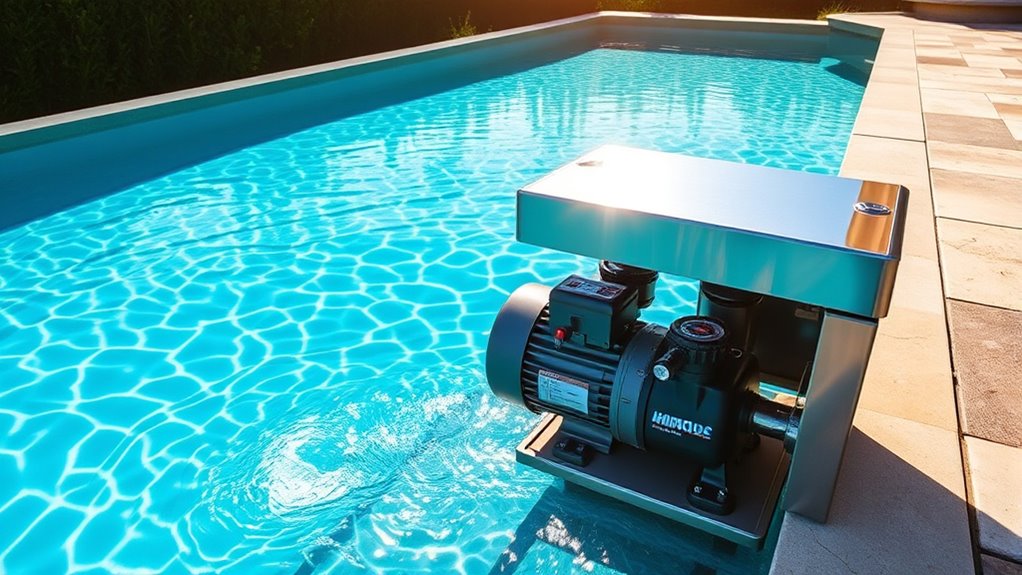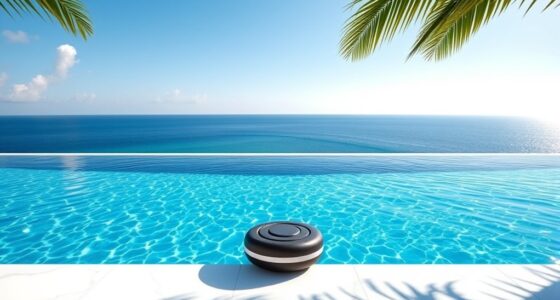To choose the right pump for your infinity pool, you need to consider its size and water volume to determine the proper flow rate. Decide between single, dual, or variable-speed pumps based on efficiency and budget. Focus on energy-efficient models with suitable horsepower, and position the pump for ideal circulation while taking into account maintenance needs. If you want specific tips on matching your pool’s unique design, keep exploring to find the perfect fit.
Key Takeaways
- Calculate the pool’s water volume accurately to determine the required flow rate and pump capacity.
- Choose a pump type (single-speed, dual-speed, or variable-speed) based on pool size, usage, and energy efficiency goals.
- Ensure the pump’s horsepower and GPM ratings match the pool’s volume for effective circulation.
- Position the pump for optimal circulation, considering proximity to water features and ease of maintenance.
- Select a durable, corrosion-resistant pump to withstand pool chemicals and environmental conditions, minimizing maintenance.
Understanding Your Pool’s Size and Water Volume

Understanding your pool’s size and water volume is essential when choosing the right pump. You need to know your pool’s dimensions—length, width, and depth—to accurately calculate its total water capacity. This helps determine the flow rate your pump must handle to keep the water clean and well-circulated. Larger pools require more powerful pumps with higher gallons-per-minute (GPM) ratings, while smaller pools need less force. Failing to match your pump’s capacity with your pool’s size can lead to poor filtration, algae growth, or equipment strain. Measure carefully and use online calculators or consult with professionals if needed. Knowing your water volume ensures you select a pump that maintains ideal circulation without overloading your system. Additionally, understanding whole-house filtration system options can help ensure your pool’s filtration is efficient and effective.
Exploring Different Types of Pool Pumps
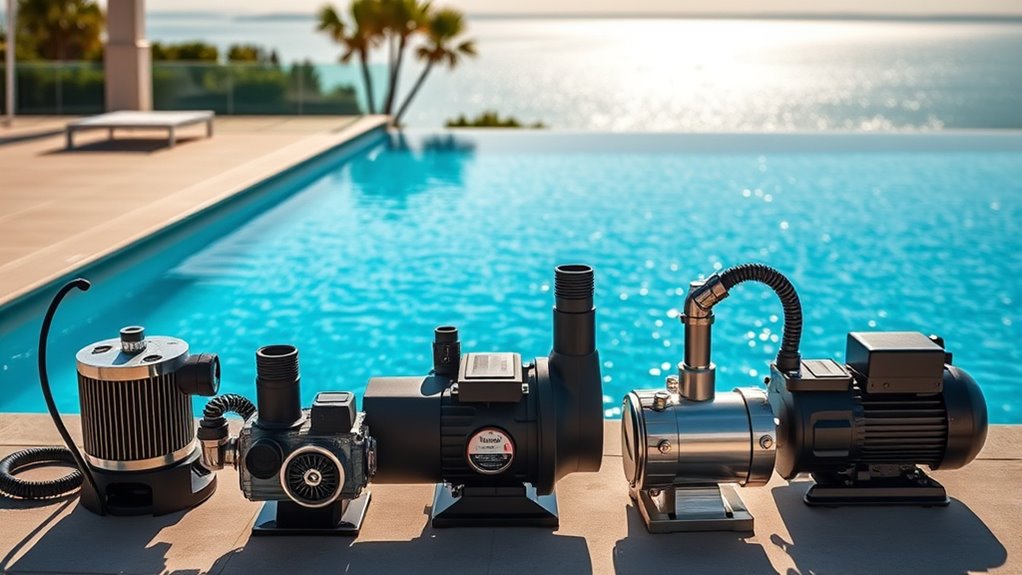
When choosing a pool pump for your infinity pool, it’s important to recognize that different types serve various needs and preferences. The most common options include single-speed, dual-speed, and variable-speed pumps. Single-speed pumps run at a constant speed, offering simplicity but less energy efficiency. Dual-speed pumps let you switch between high and low settings, saving energy during regular circulation. Variable-speed pumps provide the most flexibility, allowing you to adjust the flow rate precisely, which can considerably cut energy costs over time. Additionally, some pumps are designed specifically for large or high-flow systems. Consider your pool’s size, usage patterns, and your budget to determine the best fit. Understanding these options helps you choose a pump that balances performance, efficiency, and longevity. Energy-efficient operation is a key consideration when selecting the right pump for long-term savings and optimal pool performance.
Assessing Energy Efficiency and Power Needs

Evaluating a pump’s energy efficiency and power needs is essential to reduce operational costs and minimize environmental impact. You want a pump that balances performance with energy consumption. To do this, consider the following:
Prioritize energy-efficient pumps to cut costs and protect the environment.
- Check the pump’s wattage and horsepower ratings to ensure it matches your pool’s size and flow requirements.
- Look for ENERGY STAR or other efficiency certifications for reliable energy savings.
- Assess the pump’s flow rate to maintain proper circulation without overworking the system.
- Review the motor’s efficiency rating, as a more efficient motor consumes less power over time.
Considering Pool Design and Pump Placement
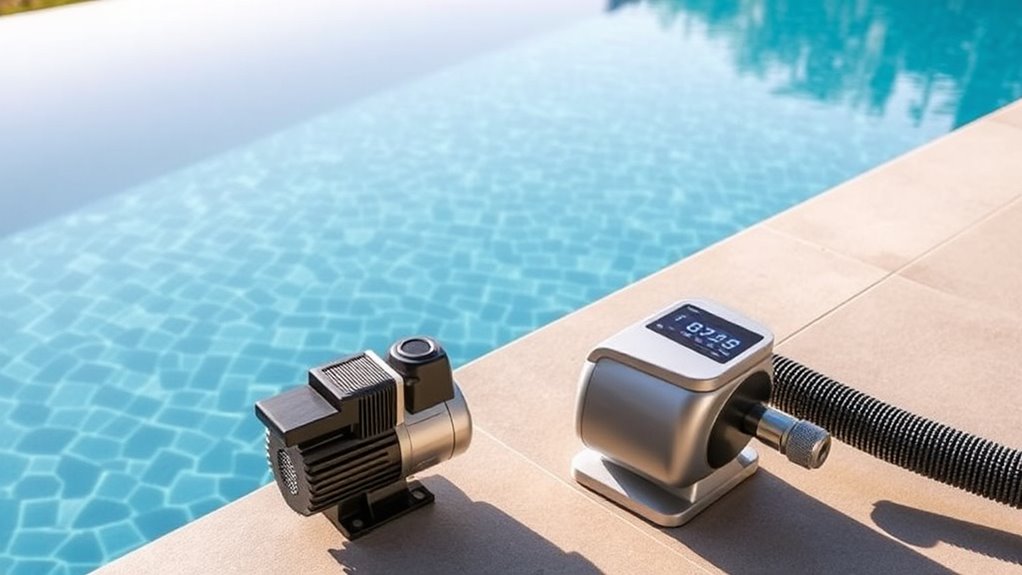
Your pool’s design directly influences the best placement of your pump. For an infinity pool, you’ll want to position the pump where it can effectively circulate water without disrupting the visual flow. Typically, placing the pump close to the water feature or spill-over area ensures efficient filtration and water movement. Consider the pool’s shape, size, and skimming needs—larger or more complex designs may require multiple inlets or outlets. Keep the pump accessible for maintenance but discreet enough not to detract from the aesthetic. Proper placement reduces strain on the pump, improves circulation, and maintains the pool’s sleek, seamless look. Always plan your pump location during the design phase to optimize performance and preserve your infinity pool’s stunning appearance. Necessary Cookies can help ensure your website functions smoothly during planning and installation.
Evaluating Maintenance Requirements and Durability
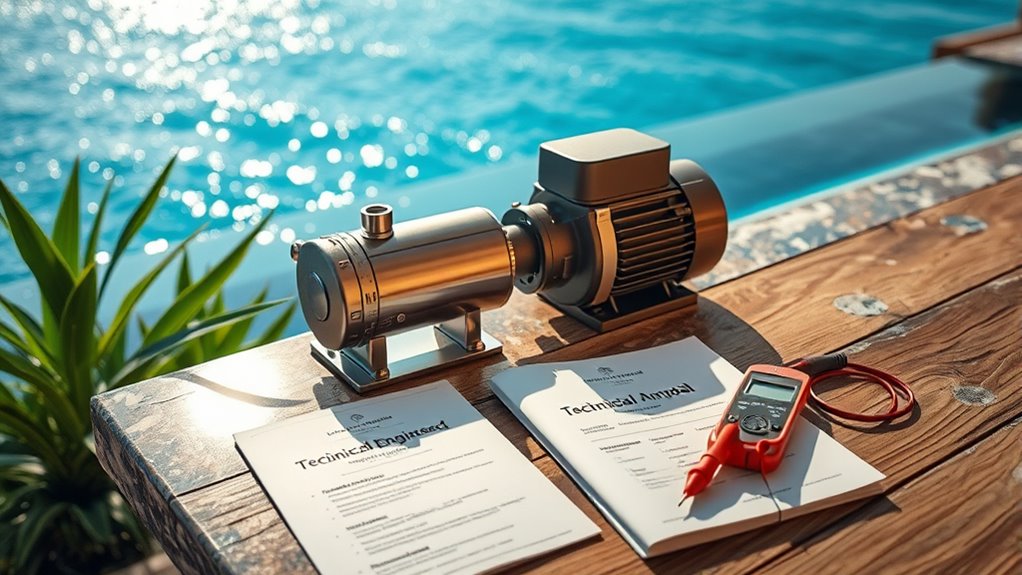
When choosing a pump, consider how often you’ll need to perform maintenance and how easy it is to access parts. You should also evaluate the materials used and whether they can withstand pool conditions over time. A durable, low-maintenance pump can save you time and money in the long run. Additionally, understanding how AI-driven diagnostics can help monitor pump performance may lead to better maintenance scheduling and increased longevity.
Maintenance Frequency and Ease
Choosing a pump that requires minimal maintenance can save you time and money in the long run, especially since infinity pools demand consistent circulation to keep the water pristine. You’ll want a pump that’s easy to access for routine checks and simple to clean. Look for models with straightforward design features that reduce the need for frequent service. Consider whether the pump has self-priming capabilities or filter systems that simplify upkeep. Also, assess how often parts like seals or impellers need replacement. Incorporating easy-to-clean components can further streamline maintenance and prolong the lifespan of your pump. Some key points to keep in mind:
- Ease of access for cleaning and inspections
- Frequency of filter or part replacements
- Built-in features that reduce manual maintenance
- Clear instructions for routine upkeep
Choosing wisely helps maintain your pool’s clarity with less effort.
Material Durability and Longevity
Selecting a pump made from durable materials is essential for ensuring it withstands the harsh conditions of an infinity pool environment. You’ll want a pump crafted from corrosion-resistant materials like stainless steel or high-quality plastics, which resist damage from chlorine, salt, and UV exposure. These materials help prevent rust and degradation over time, extending your pump’s lifespan. Consider the environment where your pool is located; coastal areas demand even tougher, salt-resistant options. Investing in a durable pump reduces maintenance costs and minimizes replacement frequency, saving you time and money. Always check manufacturer specifications for longevity guarantees. Choosing a robust, well-built pump means you’ll enjoy reliable operation and peace of mind, knowing your equipment can handle the demanding conditions of an infinity pool. Additionally, selecting a pump with material durability in mind ensures the longevity and resilience needed in challenging environments.
Making the Final Selection Based on Budget and Compatibility

Ultimately, your budget and the compatibility of the pump with your infinity pool’s system will determine your final choice. You need a pump that fits within your financial limits while working seamlessly with your pool’s existing setup. To do this, consider the following:
Your budget and system compatibility are key to choosing the right pool pump.
- Initial cost versus long-term energy efficiency
- Matching pump size and flow rate to your pool’s specifications
- Compatibility with your pool’s filtration and plumbing system
- Potential maintenance costs and availability of parts
Being aware of space‑heating basics can help you understand how pump capacity impacts overall system performance.
Balancing these factors ensures you select a pump that’s both affordable and effective. Don’t compromise on essential features just to save money upfront. Instead, weigh your options carefully to find a pump that offers the best value for your pool’s needs.
Frequently Asked Questions
How Does Pump Noise Impact the Infinity Pool Experience?
Pump noise can profoundly impact your infinity pool experience by creating distractions or disturbances, especially if it’s loud or constant. If the pump is noisy, it might make relaxing by the pool less enjoyable or interfere with conversations and peaceful moments. Choosing a quieter pump helps maintain a tranquil atmosphere, allowing you to fully enjoy your pool time without noise disruptions.
Are Variable-Speed Pumps More Cost-Effective Long-Term?
Yes, variable-speed pumps are more cost-effective long-term. They use less energy because you can adjust their speed to match your pool’s needs, reducing electricity bills. Although they cost more upfront, you save money over time through lower energy consumption and reduced wear and tear. Plus, they often come with energy-efficient features that qualify for rebates, making them a smart investment for your infinity pool.
What Safety Features Should I Look for in a Pump?
You should look for safety features like thermal overload protection, which prevents the pump from overheating, and automatic shut-off systems that activate if the pump runs dry or detects a malfunction. Ground-fault circuit interrupters (GFCIs) are essential to prevent electrical shocks. Additionally, consider pumps with protective covers and secure wiring to minimize electrical hazards. These features guarantee safe operation and help protect both you and your pool equipment.
How Does Climate Influence Pump Choice?
Imagine your pump as a sturdy sailor steering your pool’s waters. In a hot climate, you’ll want a pump with robust cooling features to prevent overheating, like a sailor with a sunhat shielding from the sun. Cold climates demand a pump with extra insulation and frost protection, like a sailor bundled up for winter. Climate shapes your pump’s armor, ensuring smooth sailing year-round.
Can I Upgrade My Pump After Installation?
Yes, you can upgrade your pump after installation. First, verify the new pump matches your pool’s specifications, including size and flow rate. Turn off the power, drain the system if needed, and disconnect the old pump. Then, install the new pump carefully, reconnect plumbing and electrical connections, and test it to ensure proper operation. Upgrading can improve efficiency and circulation, but always follow safety guidelines or consult a professional.
Conclusion
Choosing the right pump is key to keeping your infinity pool running smoothly. By understanding your pool’s size, exploring pump options, and considering energy and maintenance needs, you can make an informed decision. Remember, don’t put all your eggs in one basket—balance your budget with compatibility and efficiency. With the right pump, your pool will be the jewel of your backyard, shining bright and functioning flawlessly for years to come.
